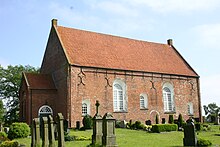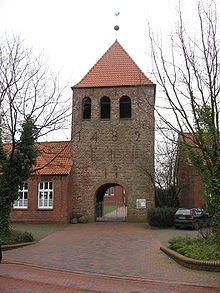Ihrhove
|
Ihrhove
Westoverledingen municipality
Coordinates: 53 ° 10 ′ 0 ″ N , 7 ° 27 ′ 14 ″ E
|
|
|---|---|
| Height : | 3 (0-5.5) m above sea level NN |
| Area : | 10.02 km² |
| Residents : | 3523 (2004) |
| Population density : | 352 inhabitants / km² |
| Incorporation : | 1st January 1973 |
| Postal code : | 26810 |
| Area code : | 04955 |
|
Map of Westoverledingen
|
|
Ihrhove belongs to the municipality of Westoverledingen in the district of Leer in East Friesland , has around 3600 inhabitants and is located between Leer and Papenburg on federal road 70 . Ihrhove is the administrative seat of the municipality.
geography
Ihrhove is located in Overledingerland , one of the four historic regions in the district of Leer. The district covers an area of 10.02 km 2 . The center of the village is located on a Geestrand , about 4 km from the Ems . The Kirchenwarft reaches a height of 5.5 m above sea level, while the Hammrich , the river march, is partly below sea level. In addition to the geest and marshland areas, west towards the Ems, the third form of landscape is the fens , which turn into bog marshes at Driever and Grotegaste .
Today Ihrhove is a central place in the municipality of Westoverledingen. In the northeast, Ihrhove borders on Folmhusen , in the southeast on yours . South is Großwolde located and the west Grotegaste.
history
middle Ages
Historically, no older traces of culture can be found before the church was built and the first traces of settlement around 1250 , which indicates that the settlement was founded according to plan. The settlement without an older predecessor in the middle of the 13th century started with yours. Today's Reformed Church was built in the middle of the 13th century as a one-room hall church with an apse . Assumptions about an older predecessor building made of wood, which is sometimes associated with the Frisian missionary Liudger , have not yet been confirmed and seem unlikely. In the pre-Reformation period, the church belonged to the Leer provost in the Münster diocese .
The medieval castle of Ihrhove - called Esseburg (Eskeborg) since 1735 - was destroyed in the course of the conquest of Overledingerland (1407-1409) by Keno tom Brok and Focko Ukena . There are conflicting oral traditions about the location of the castle. After archaeological, scientific and historical studies (2006 to 2011) there are increasing indications that the castle complex was located on what is now Bahnhofstrasse 42. For the period around 1400, eight fortified stone houses, seats of local chiefs , can be found in Overledingerland. Jeltko Iderhoff, Drost and bailiff in the office of Berum from 1515 to 1530 , was possibly chief of Ihrhove.
Modern times
In the wake of the Reformation , the parish joined the Reformed Confession around 1530 . The church received its current, shortened form in 1572 and 1789, when extensive renovations were carried out.
With the extinction of the male East Frisian princely line of the Cirksena in 1744, Ihrhove fell to Prussia like all of East Frisia. In 1806 it came to the Kingdom of Holland , in 1810 as the Ems-Orientale department to the French Empire, in 1815 to Hanover and in 1866 again to Prussia.
With the establishment of the Rheine – Norddeich Mole railway , which was initially built from Rheine to Emden (1854–1856), Ihrhove received its own train station , the use of which became even more intensive with the construction of the Leer – Groningen (Netherlands) railway in 1876. The result was a flourishing trade in Ihrhove and a steady increase in the population. Currently, the station is purely a depot , but is to be served by local rail transport again in the future . In 1912 a small railroad between Ihrhove and Rhauderfehn was put into operation on a route length of 11.6 km, which was shut down in 1972.
Ihrhove has belonged to the district of Leer since 1885 . With the formation of the municipality Westoverledingen on January 1, 1973, Ihrhove became the administrative seat and central location of the municipality. The new town hall was inaugurated in 1976.
Population development
Since the middle of the 19th century there has been a steady increase in the number of inhabitants. Since then, the population has doubled about every 50 years.
|
|
|
Development of the place name
Late medieval name forms are Iderhave, Yderahave, Yderhove, Yrhave and Yrhove. The first mention of the place "Yderhove" and the castle dates back to 1407. In oral tradition, the name "Ihrhove" is often associated with "harbor", for which the proximity to the Ems is obviously decisive. In fact, the syllable "-hove / - have / -hafe" means "church with cemetery, church square". Since the first syllable indicates the neighboring village of yours, the name Ihrhove means "church square of yours" or more freely circumscribed: "district of yours, but the one with the church".
religion
Since the Reformation, Ihrhove has been predominantly reformed. Even today, the majority of the local residents belong to the Evangelical Reformed Church. The parish office is to the left of the bell tower in the former school. A morgue was built on the right in 1911. In addition to the old rectory from 1894 on Bahnhofsstraße, the community center is available for community events. The EC and the regional church community form an association in Ihrhove with an employed preacher, their own worship services and an association that is concentrated in the EC home.
In 1860 the old reformed church was founded by the pastors Gerd Kramer (Veldhausen) and JH Vos (Uelsen) with nine people. In 1862 the first church building was built, which was replaced by the current one in 1959. The old reformed church in Neermoor and Ihrhove have shared a common pastor's position since 1974 . The church was remodeled in 1983 and a community center was added.
In the 19th century there were only a few Roman Catholic Christians; they joined the community in Westrhauderfehn . When the number increased sharply after the Second World War due to Catholic expellees, St. Francis was built in 1958/1959 as a subsidiary church of St. Bernhard in Flachsmeer .
Since the end of the 19th century, various Jewish cattle traders and their families can be identified in Ihrhove, but they did not form an independent community. Eight Jews lived there in 1908, and two in 1930. Several Jewish residents from Ihrhove perished in concentration camps.
Culture and tourism
Every year the so-called "Bottermarkt" (butter market) takes place in Ihrhove, which was held for the first time in 1979. Its origins go back to the Ihrhover butter markets of the 19th century. Even today, this event, which takes place every year on the fourth weekend in June, attracts crowds - whereas today butter and other dairy products are no longer mainly sold there.
Another attraction are the restored Gulf houses , which were removed stone by stone from their original location and rebuilt near the recreation area "Freizeitpark am Emsdeich" near Grotegaste. There they now house a restaurant and a country school home . The adjacent recreation area "Am Emsdeich Amusement Park" is a popular holiday destination. The alternative scene discotheque “Limit” in Ihrhove is also known throughout East Friesland .
traffic
The station Ihrhove , currently a depot serving, is situated on the railway lines Rheine-Norddeich Mole and Groningen empty . In the future, the station will be served by local rail transport again.
Personalities
- Harm Willms (* 1822 in Ihrhove, † 1893), farmer and Baptist pastor, known as "theologian in peasant skirt"
- Otto Galama Houtrouw (1838–1933), reformed theologian and East Frisian homeland researcher, was pastor in Ihrhove from 1867 to 1869.
- Carl Carlton , musician, a. a. with Nina Hagen , Manfred Mann , Udo Lindenberg , Peter Maffay , Robert Palmer
- Jan Brandt , writer, grew up in Ihrhove
- Enno Popkes (1904–1959), organ expert, church musician and long-time organist of the Baptist congregation Ihr , lived and died in Ihrhove.
- Olaf Kramer , professor for rhetoric and knowledge communication at the University of Tübingen, grew up in Ihrhove
literature
- Hans Joachim Albers, Heinrich Schaa, Heinz Schipper, Hermann-Josef Schleinhege: Ihrhove in the Middle Ages. Archaeological, historical and scientific search for traces . 1Druck, Leer 2011, ISBN 978-3-941578-19-7 .
- Enno Janshen (ed.): The families of the parish Ihrhove (1723-1900) . Upstalsboom-Gesellschaft, Aurich 1994, ISBN 3-925365-78-8 (Ostfrieslands Ortssippenbücher, vol. 32; German Ortssippenbücher, vol. A 188).
- Hajo van Lengen : East Frisia, history and shape of a cultural landscape. Aurich 1996.
- Wolfgang Schwarz and Renate Stutzke: Archaeological finds from the district of Leer. Oldenburg 1998.
Web links
- Hermann Adams (local chronicle of the East Frisian landscape): Ihrhove (PDF file; 45.5 kB)
- Genealogy Forum: Ihrhove
- rhaude.de: Jhrhove
- "Against the World" - an anti-homeland novel ( Memento from December 13, 2011 in the Internet Archive )
Individual evidence
- ↑ a b c d Hermann Adams (local chronicle of the East Frisian landscape): Ihrhove (PDF file; 45.5 kB), viewed January 7, 2012.
- ↑ Albers, Schaa u. a .: Ihrhove in the Middle Ages. 2011, p. 180.
- ↑ Albers, Schaa u. a .: Ihrhove in the Middle Ages. 2011, p. 180f.
- ↑ Menno Smid: East Frisian Church History . Self-published, Pewsum 1974, p. 42 (Ostfriesland im Schutz des Deiches, Vol. 6).
- ↑ Albers, Schaa u. a .: Ihrhove in the Middle Ages. 2011, pp. 65-71.
- ↑ Albers, Schaa u. a .: Ihrhove in the Middle Ages. 2011, pp. 71-90, 124-126.
- ↑ Albers, Schaa u. a .: Ihrhove in the Middle Ages. 2011, p. 54.
- ↑ Hermann Adams: A man from Ihrhove in Overledingerland. Jeltko Iderhoff. Drost and bailiff of Berum . Westoverledingen-Ihrhove 2002.
- ↑ Albers, Schaa et al.: Ihrhove in the Middle Ages. 2011, pp. 183f, 190f.
- ↑ Construction project Bremen - Groningen (Wunderline) , accessed on September 29, 2019
- ^ Federal Statistical Office (ed.): Historical municipality directory for the Federal Republic of Germany. Name, border and key number changes in municipalities, counties and administrative districts from May 27, 1970 to December 31, 1982 . W. Kohlhammer, Stuttgart / Mainz 1983, ISBN 3-17-003263-1 , p. 263 .
- ↑ Albers, Schaa et al.: Ihrhove in the Middle Ages. 2011, pp. 147–158.
- ↑ Homepage EC & Landeskirchliche Gemeinschaft Ihrhove e. V. , seen January 9, 2012.
- ↑ Protestant old reformed parish in Ihrhove (Ed.): 150 years of Protestant old reformed parish in Ihrhove 1860–2010. Self-published, Westoverledingen 2010, p. 10f.
- ↑ Genealogy forum: Flachsmeer ( Memento of the original from December 22, 2011 in the Internet Archive ) Info: The archive link was automatically inserted and not yet checked. Please check the original and archive link according to the instructions and then remove this notice. , seen Jan 7, 2012.
- ↑ Hermann Adams: The Jews in Ihrhove. Self-published, Ihrhove 2000. From this: Tabular overview of the Jewish people in Ihrhove , as seen on January 7, 2012.
- ↑ Construction project Bremen - Groningen (Wunderline) , accessed on September 29, 2019


